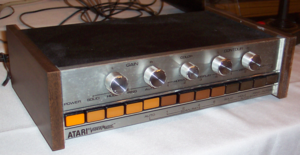Atari Video Music

The Atari Video Music
|
|
| Developer | Robert J Brown |
|---|---|
| Manufacturer | Atari, Inc. |
| Type | music visualizer |
| Release date | 1977 |
| Introductory price | $169.95; equivalent to $672 in 2016 |
The Atari Video Music (Model C240) is the earliest commercial electronic music visualizer released. It was manufactured by Atari, Inc., and released in 1977 for $169.95. The system creates an animated visual display that responds to musical input from a Hi-Fi stereo system for the visual entertainment of consumers.
By interpreting an input musical waveform, the Video Music translates the levels of musical intensity and mellowness into colors and shapes that are output to a graphical display. The console is attached to an audio source and then operated by an adhesive-backed switch box that is glued to the back of a television display. Audio signal visualizations take the basic form of a two-part diamond. The outer part represents the left audio channel while the right channel is represented by the inner part. Varying colors and shapes provide a wide variety of patters, designs, and images depending on the audio sample played.
After the unit is powered on, a toggle switch may be used to select between "TV" (music visualization inactive), and "Game" (music visualization active). When in the "Game" position, visual data is broadcast on VHF channel 3 by default, but may be set to channel 4. Unlike Atari's previous video game systems, the Video Music system's switch box featured a 75 Ohm pass-through F connector allowing the television antenna or cable to remain attached and thereby eliminating the tiresome process of detaching and reattaching the cable every time the user switched from watching normal television broadcasts to using the visualizer. Any audio source may be used for visualization including Atari's video game system audio, and visualizations can either be watched "live" on a television screen or recorded on a VCR by using a balun converter.
The Video Music hooks up to a TV through an RF switchbox. The other hook ups are left and right RCA jack inputs that hook up to an audio amplifier's RCA outputs. The face is a brushed metal plate and walnut panel sides. The unit is turned on by pushing a power button, and visualization is controlled by five potentiometer knobs and 12 additional push-buttons.
...
Wikipedia
